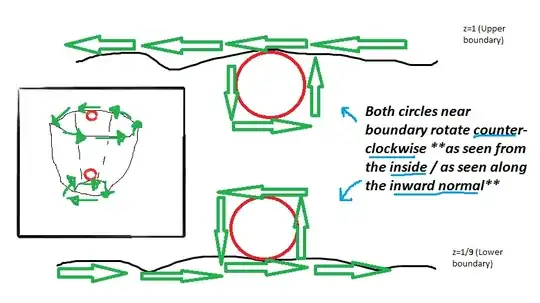2012 9C. Consider the (cutoff) paraboloid defined by $z=x^2 + y^2, \frac{1}{9} \le z \le 1$. Sketch the surface. Verify Stokes’s Theorem for for $\mathbf{F} = (-y^3,x^3,z^3)$.
Herein, I ask only about computing line integrals instead of $ \iint_S (\nabla × F )· d\mathbf{S}$, by virtue of Stokes's Theorem. I think there are two boundary curves:
$x^2 + y^2 = z \; = 1$ and $x^2 + y^2 = z \; = 1/9$.
♦ denote objects that don't need to be computed because they're dot-producted with 0.
$\bbox[5px,border:2px solid gray]{ \text{ z = 1 cross-section } }$ By virtue of the quotes on orientation here, we need the normal vector to be upward, in the direction of $(0, 0, 1).$ So the circle must be oriented anticlockwise when viewed from above $z = 1$ (as in my picture here). Thus, parameterise with $\mathbf{r}(t) = ( 1\cos t, 1\sin t, 1 )$ for all $0 \le t \le 2\pi$.
Then $\oint_{z = 1 \, curve} \mathbf{F} \cdot d\mathbf{r} = \int^{2\pi}_{0} (-\sin^3 (t) , \cos^3(t), ♦) \cdot ( -\sin t, \cos t , 0) \, dt $ = ... = $3\pi/2.$
$\bbox[5px,border:2px solid gray]{ \text{ z = 1/9 cross-section } }$ By virtue of the quotes on orientation here, we need the normal vector to be downward, in the direction of $(0, 0, -1).$ So the circle must be oriented anticlockwise when viewed from BELOW $z = 1/9$ $\iff$ the circle must be oriented clockwise when viewed from ABOVE $z = 1/9$ (as in my picture here). Thus, parameterise with $\mathbf{r}(t) = ( 1 \sin t, 1\cos t, 1/9 )$ for all $0 \le t \le 2\pi$.
This last line is wrong. I did forget the radius = $1/3$. It's supposed to be $\mathbf{r}(t) = ( \color{red} {1/3} \sin t, \color{red} {1/3} \cos t, 1/9 )$ for all $0 \le t \le 2\pi$.
Then $\oint_{z = 1/9 \, curve} \mathbf{F} \cdot d\mathbf{r} = \int^{2\pi}_{0} ( \color{red}{ \dfrac{-1}{27} } \cos^3 (t) , \color{red}{ \dfrac{1}{27} } \sin^3(t), ♦) \cdot ( \color{red}{ \dfrac{1}{3} } \cos t, \color{red}{ \dfrac{-1}{3} } \sin t , 0) \, dt \\ = - \color{red}{ \dfrac{-1}{81} } \oint_{z = 1 \, curve} \mathbf{F} \cdot d\mathbf{r}. $
In toto, $ \iint_S (\nabla × F )· d\mathbf{S} = \oint_{z = 1 \, curve} \mathbf{F} \cdot d\mathbf{r} + \oint_{z = 1/9 \, curve} \mathbf{F} \cdot d\mathbf{r} = 3\pi/2(1 - \color{red}{ \dfrac{1}{81} }) = \pi40/27$.
